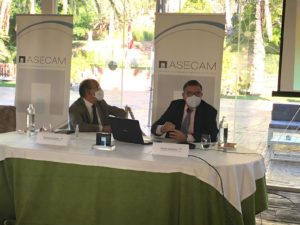
The ports of Sagunto and Valencia are strategic intermodal platforms to facilitate connectivity with the Mediterranean corridor
Manuel Guerra and Néstor Martínez, deputy directors of the PAV have participated in a conference organised by ASECAM
The Port Authority of Valencia (PAV) today warned of the danger of saturation in train traffic that is looming over the ports of Valencia and Sagunto if projects for a double platform between Valencia and Castellón and between Sagunto and Zaragoza are not undertaken as quickly as possible, as well as the “Túnel Pasante” in Valencia. This alert was launched today simultaneously by the deputy directors of the PAV, Manuel Guerra and Néstor Martínez, who are also respectively deputies to the presidency and the general management of the Port Authority.
Guerra and Martinez spoke at a breakfast organised by the Association of the Employers of Camp de Morvedre (ASECAM). In their intervention they highlighted the importance that the railway is acquiring in both port areas, both for the investments planned and for the results that are being recorded month by month. “The ports of Sagunto and Valencia are strategic intermodal platforms to facilitate connectivity with the Mediterranean corridor; large export and import companies work there for which access to the Corridor will be essential; investments are being planned that will allow a significant leap in the use of the railway, but we are in danger of saturation if we do not start planning right now a double platform for the Sagunto-Zaragoza connection and between Valencia and Castellón”, explained Manuel Guerra.
In this way, he assured that the Valencia-Castellón railway section could be affected in a few years by the increase in freight, which would saturate this axis, and he therefore considers it necessary to build a passing tunnel, as well as to double this track. Something similar is happening with the Sagunto-Teruel-Zaragoza line since, with the investment being made by the PAV, freight traffic has increased, as more than 30 trains currently run on this line and half of them carry containers. This is why it has also put on the table the need for this line to have a double platform in the near future to avoid saturation.
The President of ASECAM, Cristina Plumed, the Mayor of Sagunto, Darío Moreno, and the President of the Infrastructure Area of the Valencian Business Confederation (CEV), José Luis Santa Isabel, attended the conference. “The improvement of the infrastructures in the port of Sagunto are essential not only to attract new investment to our region but also to make our companies much more competitive; for this reason we are closely following the evolution of the railway access to the port of Sagunto, as well as the Cantabrian Corridor, because these are two very important infrastructures for us,” said the President of ASECAM, Cristina Plumed.
Data from the port of Sagunto
As reported by Nestor Martinez, Director of the exploitation of the port of Sagunto, this port installation will, throughout 2019, channel almost 7 million tonnes of which around 5.4 million tonnes will be solid goods whilst more than 1.5 million tonnes will be gas. In addition, a total of 1560 ships docked in the port of Sagunto during the last year.
Thus, the port of Sagunto is currently in second position with regard to the import of steel products, ahead of such important ports as Pasaia, Barcelona, A Coruña and Avilés and only behind Bilbao, and in fifth position with regard to the export of these goods. Similarly, it is in sixth position in terms of vehicle traffic, with more than 272,300 cars transported, and in eighth position in terms of non-continentalised goods, with a channelling of more than 2.8 million tonnes.
As for the future challenges foreseen by the PAV for the port of Sagunto, it is worth noting the opening of the Border Control Post which will have a total of ten phytosanitary inspection points, and which Martínez hopes will be able to start operating at the beginning of 2021, thus attracting more goods traffic for human and animal consumption. In addition, it is also intended to complete the quay centre II with a multipurpose terminal for which they are carrying out a ‘road show’ to publicise the project to potential investors who may be interested in it.
Improvement of infrastructures
On the other hand, the deputy director general of the PAV, Manuel Guerra, spoke about investments in improving infrastructures. At first he reported that the work on the railway access to the port of Sagunto has already started and he hopes that by the end of this year, machinery will be in place. He also explained that the project of the Regional Ministry on the development of Parc Sagunt II also includes an intermodal terminal that will connect with this railway access to the port installations.
Similarly, Guerra pointed out that 386.8 million euros will be invested within the Master Plan of the Cantabrian Corridor, destined for the electrification of this track, the work of which he hopes will be completed by the end of 2023 or the beginning of 2024.
On the other hand, the deputy director general of the PAV also explained the various investments that are being made in other infrastructure projects such as the 20.6 million euros that have been invested in improving the Sagunto-Teruel-Zaragoza railway line, or the 20 million euros earmarked for railway access to the port of Sagunto, which also has an investment of 11 million euros from Europe. In addition, an agreement has also been signed with the Ministry of Development, the Generalitat Valenciana, Adif and the Valencia City Council to create an intermodal terminal in La Fuente de San Luis, in addition to the 33 million euros that will be allocated to the electrification of the Sagunto-Teruel-Zaragoza line. In total, the PAV will allocate 88.6 million euros to promote rail intermodality.

